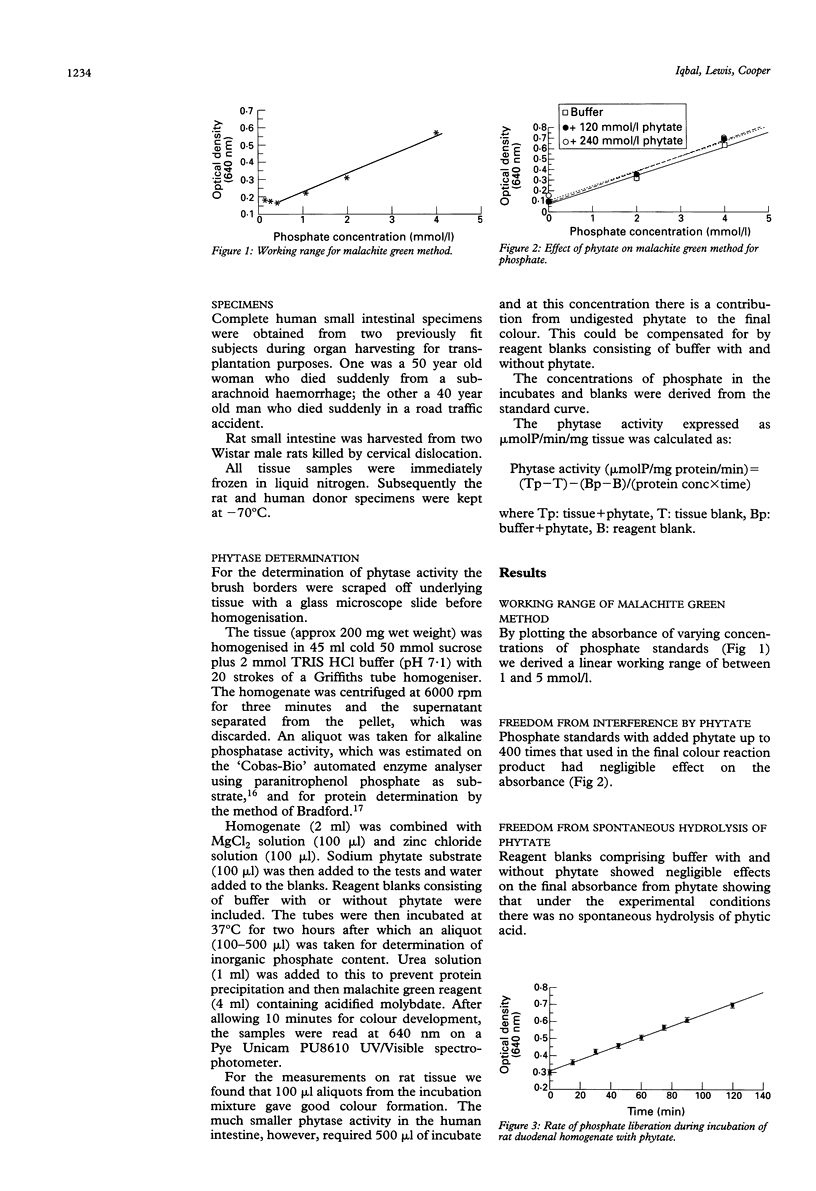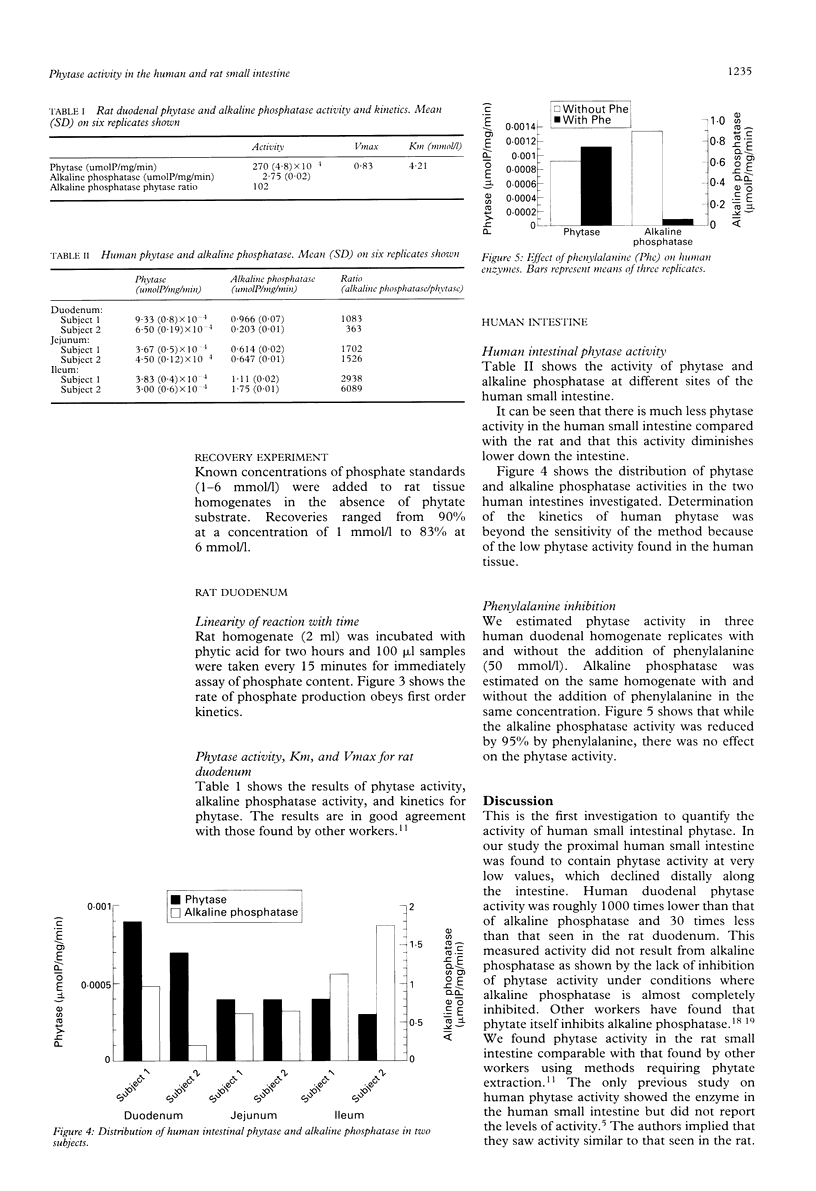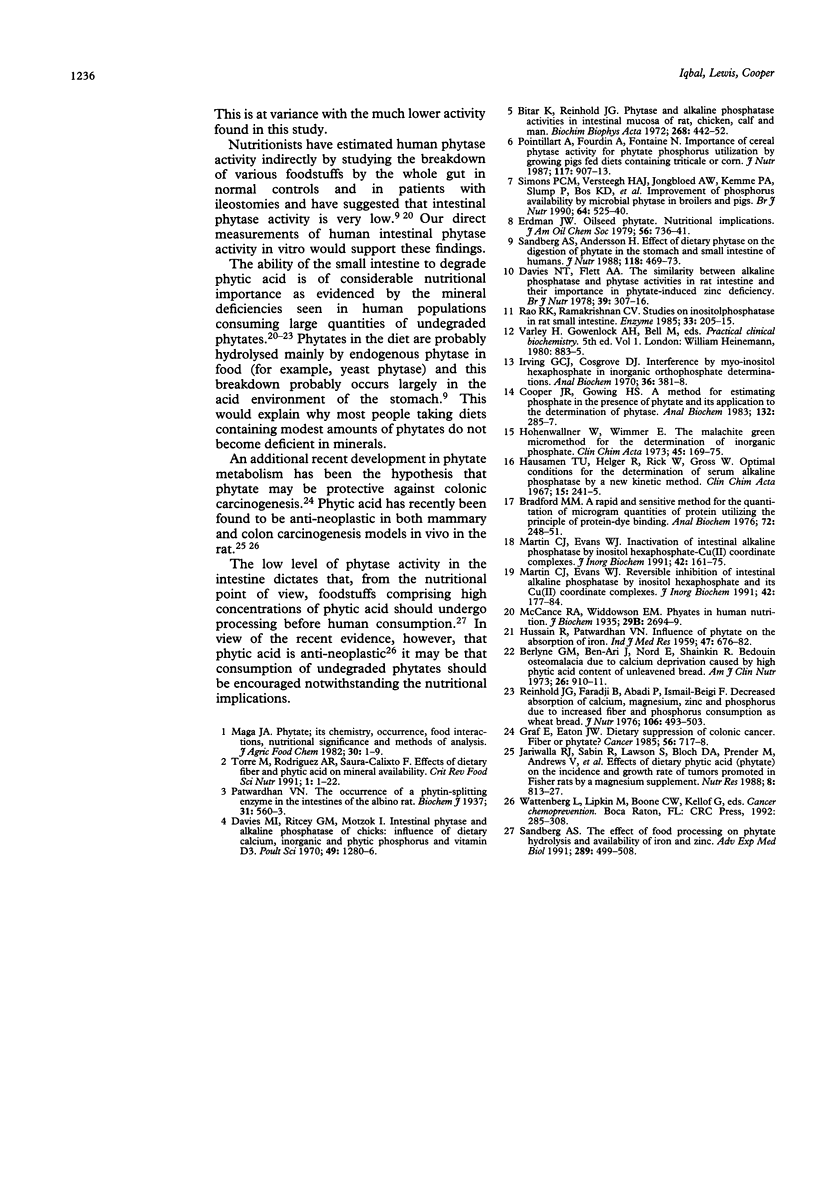Abstract
Phytate is the major storage form of phosphorus in seeds and so is a common dietary constituent. Excessive ingestion of undegraded phytates can cause mineral deficiencies in humans. In addition, phytic acid is antineoplastic in animal models of both colon and breast carcinoma. There have been no previous studies quantifying phytase activity in the human small intestine although it is present in animals. Small intestinal phytase and alkaline phosphatase activity and distribution was measured in vitro in mucosal homogenates from two human small intestinal specimens obtained from transplant donors. Rat intestine was also studied for comparison. Phytase activity was found in human small intestine at low values (30 times less than that in rat tissue and 1000-fold lower than alkaline phosphatase in the same tissue). The activity was greatest in the duodenum and lowest in the ileum. In conclusion, the normal human small intestine has very limited ability to digest undegraded phytates. Although this may have adverse nutritional consequences with respect to metabolic cation imbalances, the presence of undigested phytate in the colon may protect against the development of colonic carcinoma.
Full text
PDF



Selected References
These references are in PubMed. This may not be the complete list of references from this article.
- Berlyne G. M., Ben-Ari J., Nord E., Shainkin R. Bedouin osteomalacia due to calcium deprivation caused by high phytic acid content of unleavened bread. Am J Clin Nutr. 1973 Sep;26(9):910–911. doi: 10.1093/ajcn/26.9.910. [DOI] [PubMed] [Google Scholar]
- Bitar K., Reinhold J. G. Phytase and alkaline phosphatase activities in intestinal mucosae of rat, chicken, calf, and man. Biochim Biophys Acta. 1972 May 12;268(2):442–452. doi: 10.1016/0005-2744(72)90340-3. [DOI] [PubMed] [Google Scholar]
- Bradford M. M. A rapid and sensitive method for the quantitation of microgram quantities of protein utilizing the principle of protein-dye binding. Anal Biochem. 1976 May 7;72:248–254. doi: 10.1016/0003-2697(76)90527-3. [DOI] [PubMed] [Google Scholar]
- Cooper J. R., Gowing H. S. A method for estimating phosphate in the presence of phytate and its application to the determination of phytase. Anal Biochem. 1983 Jul 15;132(2):285–287. doi: 10.1016/0003-2697(83)90009-x. [DOI] [PubMed] [Google Scholar]
- Davies M. I., Ritcey G. M., Motzok I. Intestinal phytase and alkaline phosphatase of chicks: influence of dietary calcium, inorganic and phytate phosphorus and vitamin D3. Poult Sci. 1970 Sep;49(5):1280–1286. doi: 10.3382/ps.0491280. [DOI] [PubMed] [Google Scholar]
- Davies N. T., Flett A. A. The similarity between alkaline phosphatase (EC 3.1.3.1) and phytase (EC 3.1.3.8) activities in rat intestine and their importance in phytate-induced zinc deficiency. Br J Nutr. 1978 Mar;39(2):307–316. doi: 10.1079/bjn19780040. [DOI] [PubMed] [Google Scholar]
- Graf E., Eaton J. W. Dietary suppression of colonic cancer. Fiber or phytate? Cancer. 1985 Aug 15;56(4):717–718. doi: 10.1002/1097-0142(19850815)56:4<717::aid-cncr2820560402>3.0.co;2-4. [DOI] [PubMed] [Google Scholar]
- HUSSAIN R., PATWARDHAN V. N. The influence of phytate on the absorption of iron. Indian J Med Res. 1959 Nov;47:676–682. [PubMed] [Google Scholar]
- Hohenwallner W., Wimmer E. The Malachite green micromethod for the determination of inorganic phosphate. Clin Chim Acta. 1973 Apr 30;45(2):169–175. doi: 10.1016/0009-8981(73)90406-3. [DOI] [PubMed] [Google Scholar]
- Irving G. C., Cosgrove D. J. Interference by myo-inositol hexaphosphate in inorganic orthophosphate determinations. Anal Biochem. 1970 Aug;36(2):381–388. doi: 10.1016/0003-2697(70)90373-8. [DOI] [PubMed] [Google Scholar]
- Martin C. J., Evans W. J. Inactivation of intestinal alkaline phosphatase by inositol hexaphosphate-Cu (II) coordinate complexes. J Inorg Biochem. 1991 May 15;42(3):161–175. doi: 10.1016/0162-0134(91)84002-q. [DOI] [PubMed] [Google Scholar]
- Martin C. J., Evans W. J. Reversible inhibition of intestinal alkaline phosphatase by inositol hexaphosphate and its Cu(II) coordinate complexes. J Inorg Biochem. 1991 May 15;42(3):177–184. doi: 10.1016/0162-0134(91)84003-r. [DOI] [PubMed] [Google Scholar]
- McCance R. A., Widdowson E. M. Phytin in human nutrition. Biochem J. 1935 Dec;29(12):2694–2699. doi: 10.1042/bj0292694. [DOI] [PMC free article] [PubMed] [Google Scholar]
- Patwardhan V. N. The occurrence of a phytin-splitting enzyme in the intestines of albino rats. Biochem J. 1937 Apr;31(4):560–564. doi: 10.1042/bj0310560. [DOI] [PMC free article] [PubMed] [Google Scholar]
- Pointillart A., Fourdin A., Fontaine N. Importance of cereal phytase activity for phytate phosphorus utilization by growing pigs fed diets containing triticale or corn. J Nutr. 1987 May;117(5):907–913. doi: 10.1093/jn/117.5.907. [DOI] [PubMed] [Google Scholar]
- Rao R. K., Ramakrishnan C. V. Studies on inositolphosphatase in rat small intestine. Enzyme. 1985;33(4):205–215. doi: 10.1159/000469435. [DOI] [PubMed] [Google Scholar]
- Reinhold J. G., Faradji B., Abadi P., Ismail-Beigi F. Decreased absorption of calcium, magnesium, zinc and phosphorus by humans due to increased fiber and phosphorus consumption as wheat bread. J Nutr. 1976 Apr;106(4):493–503. doi: 10.1093/jn/106.4.493. [DOI] [PubMed] [Google Scholar]
- Sandberg A. S., Andersson H. Effect of dietary phytase on the digestion of phytate in the stomach and small intestine of humans. J Nutr. 1988 Apr;118(4):469–473. doi: 10.1093/jn/118.4.469. [DOI] [PubMed] [Google Scholar]
- Sandberg A. S. The effect of food processing on phytate hydrolysis and availability of iron and zinc. Adv Exp Med Biol. 1991;289:499–508. doi: 10.1007/978-1-4899-2626-5_33. [DOI] [PubMed] [Google Scholar]
- Simons P. C., Versteegh H. A., Jongbloed A. W., Kemme P. A., Slump P., Bos K. D., Wolters M. G., Beudeker R. F., Verschoor G. J. Improvement of phosphorus availability by microbial phytase in broilers and pigs. Br J Nutr. 1990 Sep;64(2):525–540. doi: 10.1079/bjn19900052. [DOI] [PubMed] [Google Scholar]
- Torre M., Rodriguez A. R., Saura-Calixto F. Effects of dietary fiber and phytic acid on mineral availability. Crit Rev Food Sci Nutr. 1991;30(1):1–22. doi: 10.1080/10408399109527539. [DOI] [PubMed] [Google Scholar]


